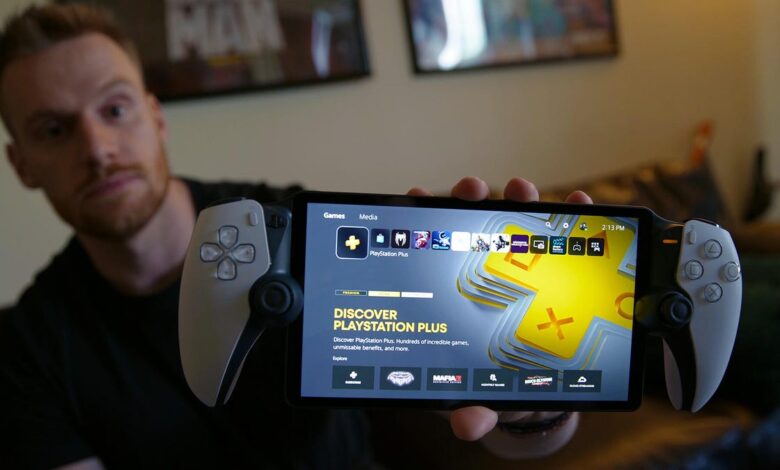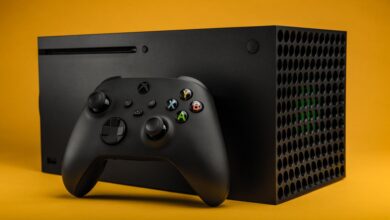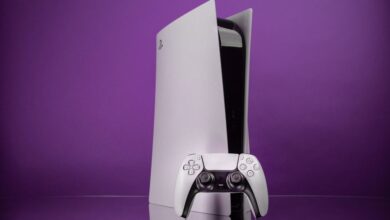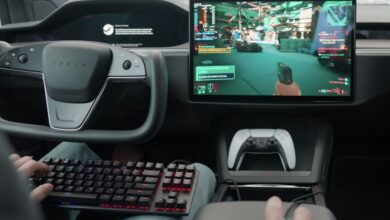PlayStation Portal Review – Video

[ad_1]
Speaker 1: Sony is reentering the handheld gaming space with the new PlayStation portal remote player. It’s a streaming handheld that needs to be connected to a PSS five at all times. I’ve had the portal for a couple days now, so I’m going to tell you what you need to know how to use it and see if it can fit into your gaming setup. Unlike Sony’s gaming handhelds of the past, the PlayStation Portable and the PS vta, the portal is strictly a remote play device. It acts as a second screen mirroring the output from a PlayStation five. This makes it a companion [00:00:30] or accessory to the PSS five, not a dedicated platform on its own. If you don’t have a PSS five, the portal will not work. This handheld is meant to be used when your main TV isn’t available or you want to play your PS five games in a different room like laying down in bed.
Speaker 1: As such, there is no internal storage or SD card slot like you’d find on a Nintendo Switch or Steam deck. Along the top, you’ll find a power button and two volume buttons on the opposite side. On the back you’ll find a 3.5 millimeter headphone [00:01:00] jack and A-U-S-B-C port for charging. Next to the power button is the PlayStation link button. This is used to connect the portal with Sony’s Pulse series of headphones such as the Explore earbuds. I have here. Stay tuned for my hands on video about these coming soon. The PlayStation Link technology is designed to help reduce audio latency when streaming your games to the handheld. However, it’s a bit disappointing that the portal doesn’t support any other Bluetooth headphones, especially when this feature is common among other portable game [00:01:30] consoles. The controller inputs on either side look and feel almost identical to the standard dual sense controller that comes packaged with the PS five.
Speaker 1: The only differences are that the analog sticks on the portal are slightly smaller, and the touch pad that sits in the middle of the dual sense has now been incorporated into the touch screen. When using the screen, a glowing rectangle will illuminate near where your thumbs sit so you can access any touch pad inputs from either side. The portal also features a microphone on the bottom, internal gyroscope [00:02:00] enhanced rumble, and haptic triggers all features you’d expect from the dual sense. The screen looks great, text is sharp and apart from some dips and quality when first connecting looks almost like I was playing games locally, it’s a little disappointing not to see the higher contrast ratio of an OLED panel, especially since more devices are moving towards that. The PlayStation portal has an eight inch LCD screen that can output a 10 80 P signal at 60 frames per second.
Speaker 1: The portal measures 12 inches across and is just under five inches in height [00:02:30] while weighing 529 grams. This puts it just above the Nintendo Switch, ole in both size and weight while measuring about the same size, but weighing less than a steam deck, all while having a larger screen than both of them. When using the device, you’ll wake it from sleep, then unlock it by pressing the PlayStation button near the top left corner of the screen. From there, it will automatically send out a signal. Looking for your PSS five. Your PS five will need a couple options turned on to allow remote play in settings, go to system, [00:03:00] then remote play, and then toggle on enable remote play. This will allow you to wake your console using just the portal, but remember, you’re basically controlling your PSS five from a different location, so you’ll need to still turn it off or put it back into rest mode.
Speaker 1: When you’re done, simply shutting down the portal will leave your home console turned on. Depending on how close you are to the PS five, we’ll determine how long it takes to find the console and wake it from rest mode. You can also do this from outside your home network. Here we are outside with the portal and [00:03:30] I am connected to the PSS five I have back home. It did take kind a while to connect, but once they found each other, it’s pretty stable. It’s running pretty much the same as it would if I was on the same wifi network. The portal is tethered to my phone right now and that’s how I’m connecting to my PS five and it’s running really nicely. Keep in mind, this device is not designed to be played outside. There are no cases, there are no screen protectors, so putting it in a bag, you could damage your screen.
Speaker 1: It’s really designed to [00:04:00] be at home. Also, the screen doesn’t get terribly bright, so even though I can see it fine in the shade here, it doesn’t look great when under direct sunlight. Playing games on the portal is really nice and when using an ideal connection feels just like the real thing. With the PSS five wired to my router and the network speeds I have, it just feels like using a portable PlayStation most of the time. Of course, this is going to vary depending on what internet you have access to. Even with my great internet, it wasn’t perfect and it still have leg [00:04:30] in the video and visual artifacts. On the rare occasion, this didn’t bug me when playing single-player titles like Spider-Man two, but I’d be cautious about taking this online for any multiplayer sessions where losing signal at all would be annoying. PlayStation’s website states a required broadband internet wifi with at least five megabits per second for use while recommending a connection of at least 15 megabits per second.
Speaker 1: For comparison’s sake, Xbox Game Passes Cloud streaming service recommends [00:05:00] 10 to 20 megabits per second. At any point during use, you can swipe down from the top right corner of the screen to access some quick controls. These include disconnecting from the PSS five. Remember, this won’t turn your console off A PlayStation Link panel that will show you when headphones are connected and how much battery life is left. Brightness controls a toggle for airplane mode and a settings menu. In here, you can adjust things like your network vibration intensity and more. I haven’t used the portal long enough to give a full rundown on battery life, [00:05:30] but back when I did my hands-on demo a couple months ago, the PlayStation rep said they were targeting something similar to the dual sense, which would put it around seven to nine hours from my brief time with it.
Speaker 1: That seems accurate. I can’t talk about PlayStation’s remote play without mentioning that this isn’t a new feature. Players can access this on PCs and phones and they compare a dual sense to that device to get all of the special controller features. I can see C Net’s YouTube backend, so I know you’re probably watching this on a phone [00:06:00] and since you need a PSS five to use the portal, you definitely already have a dual sense lying around somewhere. There’s also chiaki, which is an open source program for Steam Deck users to remotely play their PS fives. The one area that the portal has them beat is that since it’s a dedicated PSS five streaming device, it can connect and quickly get you remotely gaming. Other than that, the portal is very similar to using remote play on one of these other devices, which brings us to the price.
Speaker 1: The PlayStation portal is $200, which is actually cheaper than what I expected [00:06:30] from Sony. However, it’s a bit pricey considering I could already remote play using my phone or Steam deck and get most of the same experience. My favorite parts of the portal are how nice that screen looks, the excellent input latency and how every feature of the PSS Five’s controller, such as the enhanced Rumble and haptic triggers are present here. What I don’t like is that I already can get most of these features just by pairing that controller to my phone, tablet, pc, et cetera, and all of those devices can connect to any Bluetooth [00:07:00] headphones. And last but not least, it makes me wish I could take these console quality games offline, like with a Nintendo Switch or Steam deck. This would give it a very compelling push into the portable gaming space.
Speaker 1: The portal is an accessory to the PlayStation five, but it makes me dream of a future with a dedicated portable platform. If you’re someone who has to share their TV with roommates or family members, or you wish you could play games in bed easily, then you will find value in the portal. But I urge you to look into some of the other remote play options if the $200 [00:07:30] price tag is an issue, the PlayStation Portal remote player comes out on November 15th. Now I want to hear from you. Do you see a use case for this in your life? Let me know in the comments and thanks for watching.
[ad_2]
Source link






